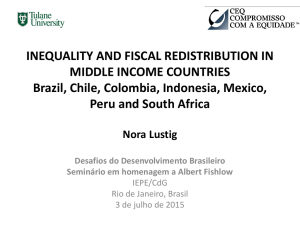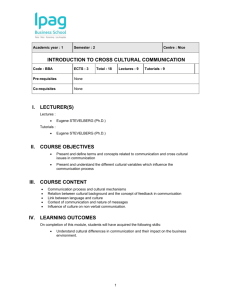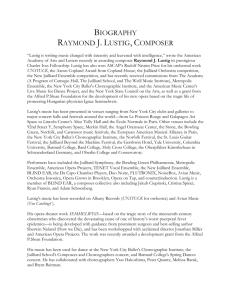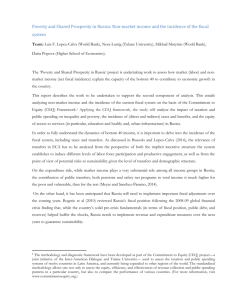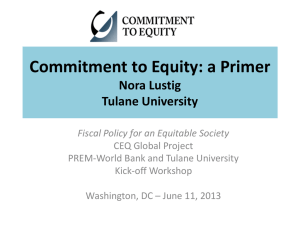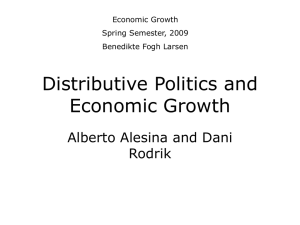Click here to the presentation.
advertisement
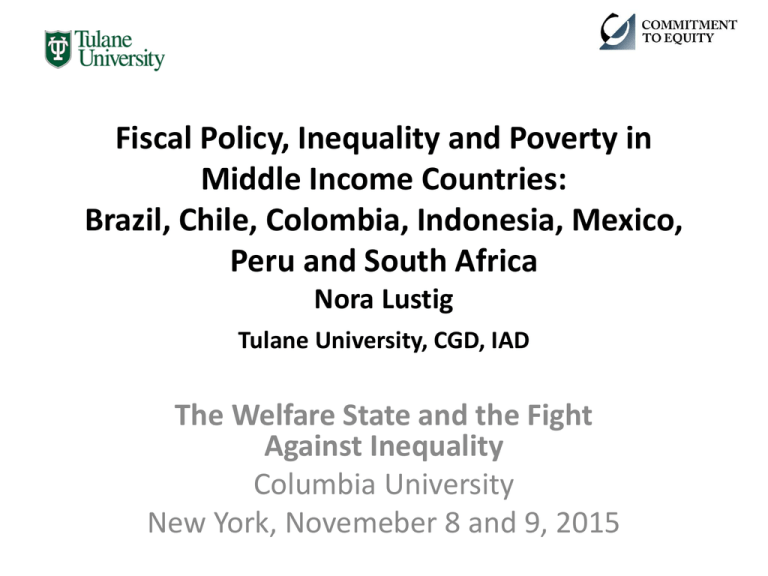
Fiscal Policy, Inequality and Poverty in Middle Income Countries: Brazil, Chile, Colombia, Indonesia, Mexico, Peru and South Africa Nora Lustig Tulane University, CGD, IAD The Welfare State and the Fight Against Inequality Columbia University New York, Novemeber 8 and 9, 2015 Measuring the Social State Three key indicators of a government’s commitment to reducing inequalities, poverty and social exclusion The share of total income devoted to social spending and how it is financed How equalizing and pro-poor net spending is Who pays for what the government spends Commitment to Equity Institute’s main goal is to respond the above NEW! CEQ Institute • Research-based policy tools • Fiscal equity information and monitoring system • Advisory and training services • Bridges to policy Thanks to the generous support of the Bill & Melinda Gates Foundation, US4.9 million to support the Institute’s for the next five years 3 CEQ Assessment: Tools Handbook: Lustig and Higgins, current version Sept 2013; includes sample Stata code => available on CEQ website CEQ Handbook 2016 (forthcoming) Lustig, Nora, editor. Commitment to Equity Handbook: Estimating the Redistributive Impact of Fiscal Policy , Tulane University and the World Bank Master Workbook: Excel Spreadsheet to present background information, assumptions and results. Lustig and Higgins, version Feb 2015 (available with permission) Diagnostic Questionnaire: = > available on website Ado Stata Files: (available with permission) 4 5 www.commitmentoequity.org CEQ Assessment: Fiscal Incidence Analysis Income after taxes and transfers Taxes Transfers Yh = Ih - ∑i TiSih + ∑j BjSjh Income before taxes and transfers Share of tax i paid by unit h Share of transfer j received by unit h 7 CEQ Assessment: Income Concepts MARKET INCOME PLUS DIRECT TRANSFERS MINUS DIRECT TAXES DISPOSABLE INCOME PLUS INDIRECT SUBSIDIES MINUS INDIRECT TAXES POST-FISCAL or CONSUMABLE INCOME PLUS MONETIZED VALUE OF PUBLIC SERVICES: EDUCATION & HEALTH FINAL INCOME 8 Main messages 1. Analyzing the tax without the spending side, or vice versa, is not really useful Taxes can be unequalizing but spending so equalizing that the unequalizing effect of taxes is more than compensated Taxes can be unequalizing by themselves but when combined with transfers make the system more equalizing than without the regressive taxes Lambert, 2001; Lustig et al., forthcoming 9 Is a particular tax or transfer equalizing? If there is a single intervention in the system, any of the progressivity measures discussed earlier will give an unambiguous answer If there is a tax and a transfer, then this is no longer the case A regressive tax can be equalizing in the sense that the reduction in inequality can be larger with the tax than without it Lambert, 2001; Lustig et al., forthcoming 10 Lambert’s Conundrum 1 2 3 4 Total Original Income x 10 20 30 40 100 Tax t 6 9 12 15 42 Transfer B 21 14 7 0 42 Net Income N 25 25 25 25 100 Source: Lambert, 2001, Table 11.1, p. 278 11 Lambert’s Conundrum The Redistributive Effect of the tax only in this example is equal to -0.05, highlighting its regressivity The Redistributive Effect of the transfer is equal to 0.19 Yet, the Redistributive Effect of the net fiscal system is 0.25, higher than the effect without the taxes! Lambert, 2001; Lustig et al., forthcoming 12 Equalizing Regressive Taxes Exist in Real Life The US and the UK had regressive equalizing taxes in the past (O'Higgins & Ruggles, 1981 and Ruggles & O’Higgins, 1981) Chile’s 1996 fiscal system had equalizing regressive taxes (Engel et al., 1999) • Redistributive Effect of Net Fiscal System (taxes and transfers together = 0.0583 (decline in Gini points) • Redistributive Effect of System with Taxes only = - 0.0076 • Redistributive Effect of System with Transfers but without Taxes = 0.0574 Note that 0.0583 > 0.0574 CEQ for Chile 2009 also shows that regressive consumption taxes are equalizing Lambert, 2001; Lustig et al., forthcoming 13 Main messages 2. Analyzing the impact on inequality only can be misleading Fiscal systems can be equalizing but poverty increasing Lustig, forthcoming 14 Main messages 3. Analyzing the impact on traditional poverty indicators can be misleading Fiscal systems can show a reduction in poverty for all possible poverty lines and yet a substantial share of the poor could have been impoverished by the combined effect of taxes and transfers Higgins and Lustig (2015) 15 Higgins and Lustig (2015) 16 Fiscal Policy, Inequality and Poverty in Middle Income Countries: Brazil, Chile, Colombia, Indonesia, Mexico, Peru and South Africa Lustig (2015) Based on: • Lustig, Nora. 2015b. Inequality and Fiscal Redistribution in Middle Income Countries: Brazil, Chile, Colombia, Indonesia, Mexico, Peru and South Africa. Evidence from the Commitment to Equity Project (CEQ). CEQ Working Paper No. 31, Center for InterAmerican Policy and Research and Department of Economics, Tulane University and Inter-American Dialogue. 18 Teams and references by country: (in parenthesis: survey year; C=consumption & I=income) 1. Bolivia (2009; I): Paz Arauco, Verónica, George Gray Molina, Wilson Jiménez Pozo, and Ernesto Yáñez Aguilar. 2014. “Explaining Low Redistributive Impact in Bolivia.” In Lustig, Nora, Carola Pessino and John Scott. 2014. Editors. The Redistributive Impact of Taxes and Social Spending in Latin America. Special Issue. Public Finance Review, May, Volume 42, Issue 3. (September 22, 2014) 2. Brazil (2009; I): Higgins, Sean and Claudiney Pereira. 2014. “The Effects of Brazil’s Taxation and Social Spending on the Distribution of Household Income.” In Lustig, Nora, Carola Pessino and John Scott. 2014. Editors. The Redistributive Impact of Taxes and Social Spending in Latin America. Special Issue. Public Finance Review, May, Volume 42, Issue 3. (November 4, 2014) 3. Chile (2009, I): Ruiz-Tagle, Jaime and Dante Contreras. 2014. CEQ Masterworkbook, Tulane University (August 27, 2014) 4. Colombia (2010, I): Melendez, Marcela and Nora Lustig. 2014. CEQ Masterworkbook, Tulane University (November 21, 2014) 5. Costa Rica (2010; I): Sauma, Juan and Diego Trejos. 2014. Social Public Spending, Taxes, Redistribution of Income, and Poverty in Costa. CEQ Working Paper No. 18, Center for InterAmerican Policy and Research and Department of Economics, Tulane University and InterAmerican Dialogue, January. (February 2014) 19 7. Ecuador: Llerena Pinto, Freddy Paul, María Christina Llerena Pinto, Roberto Carlos Saá Daza, and María Andrea Llerena Pinto. 2015. Social Spending, Taxes and Income Redistribution in Ecuador. CEQ Working Paper No. 28, Center for Inter-American Policy and Research and Department of Economics, Tulane University and Inter-American Dialogue, February. 8. El Salvador (2011; I): Beneke, Margarita, Nora Lustig y José Andrés Oliva. 2015. El impacto de los impuestos y el gasto social en la desigualdad y la pobreza en El Salvador. CEQ Working Paper No. 26, Center for Inter-American Policy and Research and Department of Economics, Tulane University and Inter-American Dialogue, February. (March 11, 2014) 9. Guatemala (2011; I): Cabrera, Maynor, Nora Lustig and Hilcías Morán. 2014. Fiscal Policy, Inequality and the Ethnic Divide in Guatemala. CEQ Working Paper No. 20, Center for InterAmerican Policy and Research and Department of Economics, Tulane University and InterAmerican Dialogue, October. (April 13, 2014) 10. Indonesia (2012; C) : Jon Jellema and Matthew Wai-Poi. 2014. CEQ Master Workbook, Tulane University and The World Bank (February 18, 2014) 11. Mexico (2010; I):Scott, John. 2014. “Redistributive Impact and Efficiency of Mexico’s Fiscal System.” In Lustig, Nora, Carola Pessino and John Scott. 2014. Editors. The Redistributive Impact of Taxes and Social Spending in Latin America. Special Issue. Public Finance Review, May, Volume 42, Issue 3. (September 2013) 20 13. Peru (2009; I): Jaramillo, Miguel. 2014. “The Incidence of Social Spending and Taxes in Peru.” In Lustig, Nora, Carola Pessino and John Scott. 2014. Editors. The Redistributive Impact of Taxes and Social Spending in Latin America. Special Issue. Public Finance Review, May, Volume 42, Issue 3. (May 1, 2013) 14. South Africa (2010; I): Inchauste, Gabriela, Nora Lustig, Mashekwa Maboshe, Catriona Purfield and Ingrid Wollard. 2015. The Distributional Impact of Fiscal Policy in South Africa. Policy Research Working Paper 7194, The World Bank, February. (May 5, 2014) 15. United States (2011; I): Higgins, Sean, Nora Lustig, Whitney Ruble and Timothy Smeeding (forthcoming) Comparing the Incidence of Taxes and Social Spending in Brazil and the United States, Review of Income and Wealth 16. Uruguay (2009; I): Bucheli, Marisa, Nora Lustig, Máximo Rossi, and Florencia Amábile. 2014. “Social Spending, Taxes and Income Redistribution in Uruguay.” In Lustig, Nora, Carola Pessino and John Scott. 2014. Editors. The Redistributive Impact of Taxes and Social Spending in Latin America. Special Issue. Public Finance Review, May, Volume 42, Issue 3. (August 18, 2014) 21 Household Surveys Used in Country Studies 1. 2. 3. 4. 5. 6. 7. 8. 9. 10. 11. 12. 13. 14. 15. Armenia: Integrated Living Conditions Survey, 2011 (I) Bolivia: Encuesta de Hogares, 2009 (I) Brazil: Pesquisa de Orçamentos Familiares, 2009 (I) Chile: Encuesta de Caracterización Social (CASEN), 2009 (I) Colombia: Encuesta de Calidad de Vida, 2010 (I) Costa Rica: Encuesta Nacional de Hogares, 2010 (I) Ecuador: Encuesta Nacional de Ingresos y Gastos de los Hogares Urbano y Rural, 2011-2012 (I) El Salvador: Encuesta De Hogares De Propositos Multiples, 2011 (I) Ethiopia: Ethiopia Household Consumption Expediture Survey and Ethiopia Welfare Monitoring survey, 2011 (C) Guatemala: Encuesta Nacional de Ingresos y Gastos Familiares, 2010 (I) Indonesia: Survei Sosial-Ekonomi Nasional, 2012 (C) Mexico: Encuesta Nacional de Ingreso y Gasto de los Hogares, 2010 (I) Peru: Encuesta Nacional de Hogares, 2009 (I) South Africa: Income and Expenditure Survey and National Income Dynamics Study, 2010-2011 (I) Uruguay: Encuesta Continua de Hogares, 2009 (I) Note: The letters "I" and "C" indicate that the study used income or consumption data, respectively. 22 Measuring the Social State Three key indicators of a government’s commitment to reducing inequalities, poverty and social exclusion The share of total income devoted to social spending and how it is financed How equalizing and pro-poor net spending is Who pays for what the government spends Size and Composition of Government Social Spending and Revenues Figure 1: Size and composition of government budgets (circa 2010) Panel a: Composition of Social Spending as a Share of GDP (ranked by social spending/GDP) 30.0% 20,000 18,000 16,000 14,000 12,000 10,000 8,000 6,000 4,000 2,000 0 25.0% 20.0% 15.0% 10.0% Direct Transfers Education Health Contributory Pensions Other Social Spending OECD Seven Countries Brazil(2009) South Africa***(2010) Mexico(2010) Colombia(2010) Peru(2009) Indonesia*(2012) 0.0% Chile**(2009) 5.0% GNI per capita (2011 PPP) 25 Composición del gasto social (Ordenado por gasto social/PIB) 25.0% 16,000.0 14,000.0 20.0% 12,000.0 10,000.0 15.0% 8,000.0 10.0% 6,000.0 4,000.0 5.0% 2,000.0 0.0% Lustig (2015c) 0.0 Transferencias directas Educación Salud Pensiones contributivas Otros gastos INB per cápita (2011 PPA) 26 Panel b: Composition of Total Government Revenues as a Share of GDP (ranked by total government revenue/GDP) 60.00% 20,000 18,000 16,000 14,000 12,000 10,000 8,000 6,000 4,000 2,000 0 50.00% 40.00% 30.00% 20.00% Direct Taxes Indirect and Other Taxes Other Revenues GNI per capita (2011 PPP) Brazil(2009) South Africa***(2010) Peru(2009) Mexico(2010) Chile**(2009) Indonesia*(2012) 0.00% Colombia(2010) 10.00% Social Security Contributions 27 Composición de ingresos totales del gobierno (Ordenado por ingresos totales/PIB) 16,000" 60.0%" 14,000" 50.0%" 12,000" 40.0%" 10,000" 8,000" 30.0%" 6,000" 20.0%" 4,000" 10.0%" 2,000" 0" 0.0%" Guatemala" Colombia" Chile"(2009)"El"Salvador" México" Perú"(2009)"" Ecuador" Costa"Rica" Uruguay" (2009)" (2010)" (2011)" (2010)"" (2011)" (2010)" (2010)" Bolivia" (2009)" Brasil" (2009)"" Impuestos"directos" Impuestos"indirectos"y"otros" Contribuciones"a"la"seguridad"social" Otros"ingresos" INB"per"cápita"(2011"PPA)" Lustig (2015c) 28 Fiscal Policy and Inequality Fiscal Redistribution: Brazil, Chile, Colombia, Indonesia, Mexico and South Africa Gini Coefficient, circa 2010 0.80 0.75 0.70 0.65 0.60 0.55 0.50 0.45 0.40 0.35 Market Income Brazil (2009) Indonesia (2012) South Africa (2010) Disposable Income Post-fiscal Income Chile (2009) Mexico (2010) Final Income Colombia (2010) Peru (2009) Source: Lustig (2015a) 30 0.8000 0.2000 0.7000 0.6000 0.1500 0.5000 0.4000 0.1000 0.3000 Market Income Gini Redistributive Effect: Market to Disposable Redistributive Effect: Brazil, Chile, Colombia, Indonesia, Mexico, Peru, South Africa, EU and the United States (Change in Gini Points: Market to Disposable Income; circa 2010) 0.2000 0.0500 0.1000 0.0000 0.0000 Pension as Market Income Pension as Transfer Market Income Gini, Pensions Mkt Inc Market Income Gini, Pensions as Transf 31 0.2500 0.8000 0.7000 0.2000 0.6000 0.1500 0.5000 0.4000 0.1000 0.3000 0.2000 0.0500 Gini de ingreso de mercado Efecto redistributivo: de ingreso de mercado a Disponible Efecto redistributivo: América Latina, EEUU y la Unión Europea (Cambios en puntos de Gini: de ingreso de mercado a disponible, circa 2010) 0.1000 0.0000 0.0000 Pensiones como ingreso de mercado Pensiones como transferencia del gobierno Gini de Ingreso de Mercado, Pens Mkt Gini de ingreso de Mercado, Pens Gob Lustig (2015c) 32 Redistributive Effect from Market to Post-Fiscal 0.0900 0.0789 0.0800 0.0700 0.0600 0.0500 0.0446 0.0370 0.0400 0.0308 0.0300 0.0151 0.0200 0.0100 0.0073 0.0061 Colombia Indonesia** 0.0000 Brazil Chile* Mexico Peru SA*** -0.0100 Direct taxes Direct transfers Indirect taxes Indirect subsidies Redistribu ve Effect 33 Table 4: Marginal Contribution of Taxes and Transfers (circa 2010) (Pensions as Market Income) Brazil Chile* Colombia Indonesia** Mexico Peru SA*** Average Redistributive Effect 0.0453 0.0340 0.0075 0.0044 0.0236 0.0099 0.0788 0.0291 Direct taxes 0.0148 0.0154 0.0018 - 0.0131 0.0055 0.0269 0.0129 Direct transfers 0.0320 0.0190 0.0057 0.0044 0.0109 0.0045 0.0593 0.0194 Redistributive Effect 0.0446 0.0370 0.0073 0.0061 0.0308 0.0151 0.0789 0.0314 Direct taxes 0.0171 0.0179 0.0019 - 0.0140 0.0060 0.0311 0.0147 Direct transfers 0.0382 0.0220 0.0057 0.0043 0.0113 0.0048 0.0711 0.0225 Indirect taxes -0.0014 0.0027 -0.0017 -0.0028 0.0027 0.0052 0.0000 0.0007 Indirect subsidies 0.0008 0.0004 0.0015 0.0052 0.0047 - - 0.0025 Direct taxes 0.1738 0.3481 0.1373 0.0000 0.2411 0.3853 0.1109 0.1995 Direct transfers 0.5310 0.9064 0.9233 0.6248 0.7931 0.9612 1.0165 0.8223 Indirect taxes -0.0536 -0.0172 -0.1986 -0.0513 0.0129 0.0527 -0.0788 -0.0477 Indirect subsidies 0.8295 0.7978 0.5034 0.0645 0.2457 0.0000 0.0000 0.3487 Marginal Contributions From Market to Disposable Income From Market to Post-fiscal Income Kakwani 34 Fiscal Policy and Poverty Reduction Fiscal Policy and Poverty Reduction (circa 2010) (Change in Headcount Ratio from Market to Post-fiscal Income for Pensions in Market Income and Pensions in Transfers; in %) a 15.0% 10.0% 5.0% 0.0% -5.0% -10.0% -15.0% -20.0% -25.0% -30.0% -35.0% Brazil (2009) Colombia (2010) Indonesia* (2012) Peru (2009) Mexico (2010) South Africa** (2010) Pensions as Market Income Chile*** (2009) Pensions as Transfer 36 Are the poor impoverished by taxes net of cash transfers? Brazil: • 36.8% of post-fisc poor are fiscally impoverished • Total fiscal impoverishment over USD $700 million • Impoverished pay $0.19 per person per day (10% of their incomes) in net taxes on average Source: Higgins and Lustig (2015) 37 Higgins and Lustig (2015) 38 Higgins and Lustig (2015) 39 Spending on Education and Health: How Pro-poor? 1 Progressivity of Transfers: A Diagrammatic Representation Cumulative share of income and transfers Globally progressive transfer in absolute terms (pro-poor): per capita benefit declines with pretransfer income (not necessarily everywhere) Concentration Curve lies above the diagonal ð Concentration Coefficient < 0 ð Kakwani Index > 0 Globally progressive transfer: benefit as a share of pre-transfer income declines with income (not necessarily everywhere) Concentration Curve lies above pre-transfers Lorenz curve ð Concentration Coefficient < Gini for pre-transfer income ð Kakwani Index > 0 0 Proportional transfer: benefit as a share of pre-transfer income is the same for everyone Concentration Curve coincides with the pre-transfer Lorenz curve ð Concentration Coefficient = Gini for pre-transfer income ð Kakwani Index = 0 0 Transfer neutral in absolute terms: per capita benefit is equal for everyone. Concentration Curve coincides with the diagonal ð Concentration Coefficient = 0 ð Kakwani > 0 Pre-transfer Lorenz curve Globally regressive transfer: benefit as a share of pre-transfer income increases with income (not necessarily everywhere) Concentration Curve lies below market income Lorenz curve ð Concentration Coefficient > Gini for pretransfer income ð Kakwani Index < 0 Cumulative share of population (ordered by market income) 1 41 Progressivity and Pro-poorness of Education and Health Spending. Summary of Results Educ&Total Pre$school Primary Secondary Pro$poor&CC&is& Same&per& Progressive&CC&Pro$poor&CC&is& Same&per& negative capita&for&al ;& positive&but& negative capita&for&all;& CC&=0 lower&than& CC&=0 market& income&Gini Progressive&CC&Pro$poor&CC&is& Same&per& positive&but& negative capita&for&all;& lower&than& CC&=0 market& income&Gini Progressive&CC&Pro$poor&CC&is& Same&per& positive&but& negative capita&for&all;& lower&than& CC&=0 market& income&Gini Brazil&(2009) + + + &Chile&(2009) + + + Colombia&(2010) + + + Indonesia&(2012) + na + Mexico&(2010) + + + Peru&(2009) + + + South&Africa&(2010) + + + *CC&is&almost&equal&to&market&income&Gini&coefficient If&the&Concentration&Coefficient&is&higher&or&equal&to&$0.5&but&not&higher&than&0.5,&it&was&considered&equal&to&0. Source: Lustig (2015b + + + Tertiary Progressive&CC& Pro$poor&CC&is& Same&per& positive&but& negative capita&for&all;& lower&than& CC&=0 market& income&Gini Health Progressive&CC&Regressive&CC& Pro$poor&CC&is& Same&per& positive&but& positive&AND& negative capita&for&all;& lower&than& higher&than& CC&=0 market& market& income&Gini income&Gini + + + + + + + + + + + + + + Progressive&CC& positive&but& lower&than& market& income&Gini + + + + 42 Who pays for what the government spends? Net Payers to the Fiscal System (circa 2010) Panel a: Pensions as Market Income Net Receivers Net Payers Indonesia*(2012) Chile**(2009) Colombia(2010) Mexico(2010) Peru(2009) South Africa***(2010) Brazil(2009) y<1.25 Source: Lustig (2015b 1.25<=y<2.5 2.5<=y<4 4<=y<10 10<=y<50 y>=50 44 What Type of Social State Emerges from Country Studies Combined? What Kind of Social State in XXI Century? • Lindert (2004) – Extent of tax-based redistributive spending depends on democracy, demography and development – In the past, Robin Hood paradox: more unequal, less redistributive. 46 Do Richer Countries Spend More on the Social State? Yes Primary and Social Spending/GDP vs GNI/capita 45% BRA 40% BOL 35% ZAF 30% URY AMR PER 25% 20% ZAF SLV CHL MEX BRA COL 15% GTM BOL ETH 10% IND SLV PER ETH GTM 5% URY AMR IND MEX CHL COL 0% 0 2000 Source: Lustig (2015a) 4000 6000 8000 10000 12000 14000 16000 GNI/Capita (2011 PPP) Primary Spending/GDP Social Spending/GDP 18000 20000 48 Do Countries that Spend More, Redistribute More? Yes Figure 4. Redistribution and social spending, 2010 0.2000 0.1800 ZAF Restributive Effect 0.1600 0.1400 BRA 0.1200 CHL 0.1000 MEX 0.0800 0.0600 COL 0.0400 IDN 0.0200 0.0000 0.0% 5.0% PER 10.0% 15.0% 20.0% 25.0% 30.0% Social Spending Source: Lustig (2015b 50 Do Richer Countries Redistribute More? Yes Change in Gini: Disposable vs Market (in GINI points) 0.08 ZAF 0.07 0.06 0.05 0.04 BRA AMR URY 0.03 MEX CRI JOR 0.02 BOL ETH PER LKA 0.01 SLV GTM IND 0.00 0 Source: Lustig (2015a) 2000 4000 6000 8000 GNI/Capita 10000 12000 14000 16000 52 Do More Unequal Countries Redistribute More? Robin Hood is With Us! A. Redistribution and market income inequality 0.2000 0.1800 ZAF 0.1600 Redistribuive Effect 0.1400 BRA CHL 0.1200 0.1000 MEX 0.0800 0.0600 0.0400 0.0200 PER COL IDN 0.0000 0.3800 0.4300 0.4800 0.5300 0.5800 0.6300 0.6800 0.7300 0.7800 0.8300 Source: Lustig (2015b Gini Market Income 54 B. Final income inequality and market income inequality 0.60 ZAF 0.55 Gini Final Income COL 0.50 PER 0.45 BRA MEX CHL 0.40 IDN 0.35 0.38 0.43 0.48 0.53 0.58 0.63 0.68 0.73 0.78 0.83 Gini Market Income Source: Lustig (2015b 55 References • • • • • Duclos, Jean-Yves and Abdelkrim Araar. 2007. Poverty and Equity: Measurement, Policy and Estimation with DAD (Vol. 2). Springer. Chapters 7 and 8. (available online) Higgins, Sean and Nora Lustig. 2015. Can a poverty-reducing and progressive tax and transfer system hurt the poor? ECINEQ Working Paper No. 363, April. Lambert, Peter J. (2001). The Distribution and Redistribution of Income: A Mathematical Analysis. Manchester University Press. Third Edition. Chapter 11. (not available online) Lindert, Peter (2004). Growing Public, Cmbridge University Press Lustig, Nora, Ali Enami and Rodrigo Aranda. “The Analytics of Fiscal Redistribution.” Chapter in Lustig, Nora, editor, Commitment to Equity Handbook: Estimating the Redistributive Impact of Fiscal Policy. , Tulane University and the World Bank (Forthcoming) Lustig, Nora. 2015a. “The Redistributive Impact of Government Spending on Education and Health: Evidence from 13 Developing Countries in the Commitment to Equity Project” Chapter 17 in Gupta, Sanjeev, Michael Keen, Benedict Clements and Ruud de Mooij, editors, Inequality and Fiscal Policy, Washington: International Monetary Fund. Lustig, Nora. 2015b. Lustig, Nora. 2015b. Inequality and Fiscal Redistribution in Middle Income Countries: Brazil, Chile, Colombia, Indonesia, Mexico, Peru and South Africa. Evidence from the Commitment to Equity Project (CEQ). CEQ Working Paper No. 31, Center for Inter-American Policy and Research and Department of Economics, Tulane University and Inter-American Dialogue. Lustig, Nora. 2015c. “El impacto del sistema tributario y el gasto social en la distribución del ingreso y la pobreza en América Latina: Bolivia, Brasil, Chile, Colombia, Costa Rica, Ecuador, El Salvador, Guatemala, México, Perú y Uruguay.” Informe para la División de Administración Fiscal y Municipal del Banco Interamericano de Desarrollo. Lustig, Nora, editor. 2016. Commitment to Equity Handbook: Estimating the Redistributive Impact of Fiscal Policy. (Forthcoming) World Bank. 2014. Ethiopia. Poverty Assessment, Chapter 5. (Based on CEQ Assessment for Ethiopia) 56 Thank you! 57
